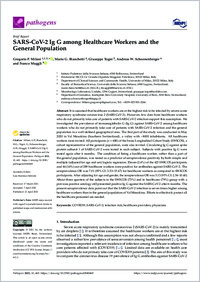SARS-CoV-2 Ig G among HealthcareWorkers and the General Population
- Milani, Gregorio P. Istituto Pediatrico della Svizzera Italiana, Bellinzona, Switzerland - Fondazione IRCCS Ca’ Granda Ospedale Maggiore Policlinico, Milan, Italy - Department of Clinical Sciences and Community Health, University of Milan, Milan, Italy
- Bianchetti, Mario G. Faculty of Biomedical Sciences, Università della Svizzera italiana, Switzerland
- Togni, Giuseppe Microbiology Laboratory, Unilabs, Coppet, Switzerland
- Schoenenberger, Andreas W. Department of Geriatrics, Inselspital, Bern University Hospital, University of Bern, Bern, Switzerland
- Muggli, Franco Faculty of Biomedical Sciences, Università della Svizzera italiana, Switzerland
-
2021
Published in:
- Pathogens. - MDPI. - 2021, vol. 10, no. 4, p. 6
English
It is assumed that healthcare workers are at the highest risk to be infected by severe acute respiratory syndrome coronavirus 2 (SARS-CoV-2). However, few data from healthcare workers who do not primarily take care of patients with SARS-CoV-2 infection support this assumption. We investigated the prevalence of immunoglobulin G (Ig G) against SARS-CoV-2 among healthcare workers who do not primarily take care of patients with SARS-CoV-2 infection and the general population in a well-defined geographical area. The first part of the study was conducted in May 2020 in Val Mesolcina (Southern Switzerland), a valley with ~8000 inhabitants. All healthcare workers were invited. All participants (n = 488) of the Swiss Longitudinal Cohort Study (SWICOS), a cohort representative of the general population, were also invited. Circulating Ig G against spike protein subunit 1 of SARS-CoV-2 were tested in each subject. Subjects with positive Ig G were tested again after 6 months. The condition of being a healthcare worker, rather than a part of the general population, was tested as a predictor of seroprevalence positivity by both simple and multiple (adjusted for age and sex) logistic regression. Eleven (2.6%) of the 423 SWICOS participants and 46 (16%) out of 289 healthcare workers were positive for antibodies against SARS-CoV-2. The seroprevalence OR was 7.01 (95% CI: 3.53–15.47) for healthcare workers as compared to SWICOS participants. After adjusting for age and gender, the seroprevalence OR was 5.13 (95% CI: 2.54–10.40). About three quarters of the subjects in the SWICOS (73%) and in healthcare (79%) group with a previous positive serology still presented positive Ig G against the SARS-CoV-2 after 6 months. The present seroprevalence data point out that the SARS-CoV-2 infection is seven times higher among healthcare workers than in the general population of Val Mesolcina. Efforts to effectively protect all the healthcare personnel are needed.
- Language
-
- English
- Classification
- Medicine
- License
- Open access status
- gold
- Identifiers
-
- RERO DOC 333638
- DOI 10.3390/pathogens10040465
- ARK ark:/12658/srd1319189
- Persistent URL
- https://n2t.net/ark:/12658/srd1319189
Statistics
Document views: 229
File downloads:
- Texte intégral: 195
